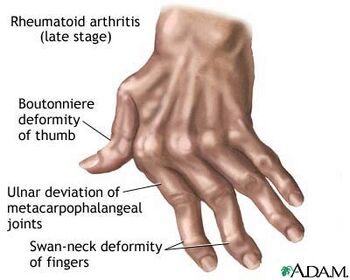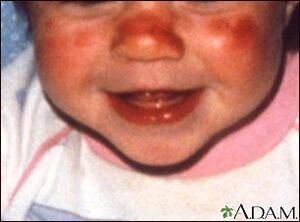Arthritis and rheumatic diseases
Overview
According to the Arthritis Foundation arthritis is "a complex family of musculoskeletal disorders consisting of more than 100 different diseases or conditions that destroy joints, bones, muscles, cartilage and other connective tissues, hampering or halting physical movement". Arthritis is the leading cause of disability in the United States. It is also one of the most commonly misunderstood ailment. The root cause is unknown for most of these diseases. Currently, there exists no cure.
The Numbers
- 50 million Americans have an arthritis
- 2/3 are under the age of 65
- 300,000 children have arthritis
- 44 million outpatient visits per year due to arthritis
- 992,100 hospital visits due to arthritis
- By 2030, 67 million Americans will have arthritis
- $128 billion/year is spent in the US on arthritis related health care costs
- 27 million Americans have osteoarthritis
- 1.3 million Americas have rheumatoid arthritis
- 2% have fibromyalgia
- 2% have psoriatic arthritis
Types
Arthritis
Arthritis is defined as and literally means joint inflammation. There are four common types of arthritis: osteo-, rheumatoid, juvenile, and psoriatic.

Osteoarthritis

Osteoarthritis is caused by the breakdown of cartilage due to weight, injury, age, genetics, and/or muscle weakness. It is the most common form of arthritis afflicting 27 million Americans. It is also one of the few with a known cause, although not preventable if your genetically predisposed.
Symptoms of osteoarthritis include:
- joint soreness
- joint stiffness
- morning stiffness
- joint pain
- loss of coordination
Osteoarthritis can occur in hips, knees, the lower back, neck and joints of the fingers. The joints can be affected in any combination, on any side, regardless of symmetry.
Osteoarthritis is arguably the easiest of the major arthritis' to diagnose.
Overtime, joints can deteriorate at which point joint replacement may be inevitable. This is made possible by the field of tissue engineering. See Hip Replacements, by Matthew Osso.
Rheumatoid Arthritis
Rheumatoid arthritis (RA) is an autoimmune disease that causes inflammation of the membranes that line the body's joints. Autoimmune diseases are defined as diseases that cause your body to attack itself. As with most autoimmune diseases, RA is most common in women.
Genetic markers have been identified. These markers are used to predict if you may develop RA. Though they can predict the possibility, they do not provide any definitive results. RA is a difficult disease to diagnose. If it is not caught earlier and treatment begun major damage can occur.
Symptoms of RA are intermittent making it hard to diagnose (this is again a result of autoimmune diseases). The most common symptoms of RA include:

- joint damage
- organ damage
- decreased range of motion
- warm joints
- inflammation and swelling
- joint pain (symmetrical)
- fatigue
- anemia
- lose of appetite
- low grade fever (a symptom of all rheumatic diseases)
- rheumatoid nodules
Rheumatoid arthritis can damage cartilage, tendons, and ligaments. Therefore, replacement options such as ACL Reconstruction, by Anthony Valle are beneficial. RA also leads to joint deformation and patients will require joint replacement options. RA also can lead to major organ damage causing need for heart, lung, and kidney replacements. See Dialysis, by Kyle Reed, Hip Replacements, by Matthew Osso, Artificial Hearts, by Manuel Escanciano and Charles Beyrouthy.
Juvenile Arthritis
Juvenile arthritis is defined as any autoimmune and inflammatory condition found in children 16 years old or younger. Unlike the arthritis' above JA affects not only the joints but also the eyes, skin, and gastrointestinal tract. Similar tissue engineering treatments may be required.
Psoriatic Arthritis
Psoriatic Arthritis (PsA) is an arthritis in conjunction with psoriasis. This autoimmune arthritis typically appears 10 years post diagnosis or psoriasis. Some signs you have PsA include: nail pitting and silver scaly rashes.
The arthritis is caused by the thicken of synovium tissue, the tissue that is found around joints. This allows for potential tissue engineering solutions. Further research is needed to discover ways to prevent this thickening. PsA has the unique opportunity of knowing you may get it in 10 years. If a vaccine of sorts can be created to prevent the thickening, this could be given to all psoriasis patients hopefully preventing PsA.
PsA causes major joint damage early. Require such treatments as Hip Replacements, by Matthew Osso and ACL Reconstruction, by Anthony Valle. The current medications for pain relief can also lead to heart attacks.
Ankylosing Spondylitis
AS is a condition that effects the pelvis, spine, and hips. Tissue engineering solutions: See Artifical Vertebrae, by Matthew McNulty.
Rheumatic Diseases
Lupus
Lupus is an autoimmune disease that affects nearly every organ system in the body. These include skin, joints, kidneys, heart, lungs, and the central nervous system! Lupus is incredibly difficult to diagnose. Some people only find out they have lupus once their kidneys begin to fail. Lupus is most common in women of African decent and then Asians; it is uncommon in Caucasians and men but it can occur.
Symptoms that are typical for lupus patients include:

- low grade fever
- hair loss
- fatigue
- chest pain from breathing
- mouth sores
- "butterfly rash"
- general discomfort
- light sensitivity
- arrhythmia
- difficulty breathing- coughing up blood
- swollen lymph nodes
Lupus is one disease that will always keep tissue engineers employed. See Dialysis, by Kyle Reed, Hip Replacements, by Matthew Osso, ACL Reconstruction, by Anthony Valle.
Fibromyalgia
Fibromyalgia is a rheumatic syndrome that is characterized by wide-spread pain and tenderness at "trigger points". There are 17 trigger points that are agreed upon by rheumatologists.
Fibromyalgia is a controversial syndrome. Several people do not believe it is a true illness. In fact, it took many years to be recognized as an actual health issue.

The symptoms of fibromyalgia are very vague:
- difficulty sleeping
- fatigue
- chronic pain
- thinking and memory problems -"fibro fog"
- numb and tingling feeling
- irritable bowel syndrome
- random additional pain
Because of this, diagnosis is via exclusion. No true test exists.
Fibromyalgia is believed to be caused by overactive nerves. Further research is needed in this area. Potential treatments that target nerves can be created.
Gout

Gout is a condition caused by an access of uric acid. It has been discovered excessive beer, red meat, and cigarettes can increase the uric acid level. The uric acid forms crystals in the synovial fluid that surrounds major joints.
Tissue engineers can potentially study the production of uric acid crystals to develop a way to reverse or prevent this crystallization.
Ehlers-Danlos Syndrome
Ehlers-Danlos Syndrome is a syndrome caused by weak collagen. There is potential for tissue engineering here. Either discovering ways to strengthen this collagen or replace it. See Artificial Skin, by Katie Geldhart and Timothy Ma and Cell Sheet Tissue Engineering, by Julia Tomaszewski.
Giant Cell Arteritis
Giant Cell Arteritis causes the walls of the arteries to become inflamed which in turn restricts blood flow. Potential devices similar in design to stents could be created. See Stents, by Ryan Colombo
Myositis
Myositis is a rheumatic disease that causes inflammation of the heart, lungs, intestines, and skin. See Artificial Skin, by Katie Geldhart and Timothy Ma, Lung on a Chip, Artifical Hearts.
Sjogren's Syndrome
Sjogren's syndrome is a syndrome that causes excessive dryness in the eyes and mouth. It also causes inflammation of lungs, kidneys, and liver. See Dialysis, by Kyle Reed and Lung on a Chip.
Potential for Tissue Engineering
Existing Solutions
Many of these ailments are degenerative, meaning they will destroy joints and/or organs. Therefore, there is an extensive need for solutions that only tissue engineering can provide. The most common engineered solutions are joint replacements. Depending on the condition, the joints requiring replacement can include knees, hips, and shoulders. Treatments such as spinal fusion can also be necessary.
For diseases such as lupus that affect your internal organs, artificial organs are critical. Artificial kidneys, valves, bladder, hearts, lungs all can be used in patients with severe organ degeneration, directly or indirectly, caused by arthritis and rheumatic diseases.
Potential Solutions
Potential solutions for these ailments can be found above below each disease.
Current Research
According to the US government clinical trials website, there are currently over 3500 clinical trials for arthritis in the works. 2810 of these are specifically for rheumatic diseases. 1393 are specifically for osteoarthritis.
Patient's Perspective
Resources
[1] Arthritis Foundation <http://www.arthritis.org>
[2] Clinical Trials <http://www.clinicaltrials.gov>
[3] Arthritis Today <http://www.arthritistoday.org/conditions/index.php>
[4] Medline Plus <http://www.nlm.nih.gov/medlineplus/arthritis.html>
[5] Medline Plus: Fibromyalgia <http://www.nlm.nih.gov/medlineplus/fibromyalgia.html>
[6] Center for Disease Control "Fibromyalgia" <http://www.cdc.gov/arthritis/basics/fibromyalgia.htm>
[7]
